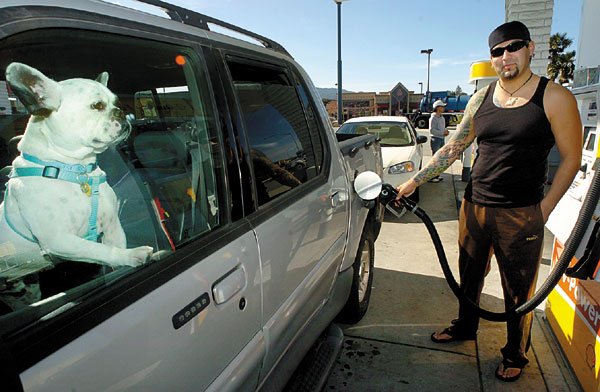Gilroy
– Guillermo Cervantes watched gas prices rise 10 cents a gallon
within a recent two-day period.
Gilroy – Guillermo Cervantes watched gas prices rise 10 cents a gallon within a recent two-day period.
“As spring nears, more people go out and use their cars, and there is more demand for gas,” said the Gilroy resident as he fueled his red mini-van at the Unocal 76 gas station on 10th street.
But seasonal demand is not the only reason gas prices rise.
The biggest factor is the price of crude oil, followed by the cost of refining, according to industry experts. When crude oil prices are stable, gas prices can fluctuate due to supply disruptions stemming from world events, or domestic problems such as pipeline outages.
And, when gas prices are stable, retail prices tend to gradually rise before and during summer. If crude oil prices remain unchanged, gas prices would typically increase by 10 to 20 cents from January through summer.
And, Cervantes has seen has seen prices rise dramatically.
The Unocal 76 gas station on 10th Street is at $2.69, while Chevron across the street is at $2.79, about 10 cents more than a week ago. The national average is $2.23 a gallon. Last April, the least expensive gas was $2.82 at Shell on Leavesley Road.
As gas again approaches, and perhaps surpasses, $3 a gallon as it did last summer, it hits commuters hard.
Hollister resident Marty Richman said he’s been paying more attention to his gas expenses, both because of higher prices and because he recently started a job in San Jose. Richman has a round-trip commute of 84 miles per day. That means he spends $50 per week on gas just to get back and forth to work.
“Boy, that adds up,” he said.
Richman added that higher gas prices have definitely affected how he approaches driving.
“The difference it makes for me isn’t that I stop getting gas where I want to, but that I combine trips,” he said. “If I need something in Gilroy, I’ll stop by on the way home. That makes a big difference.”
Ramon Solorio a Gilroy resident thinks the prices are going up because of the war, but he doesn’t mind much.
“Gas is expensive, but I’m used to the prices,” said Solorio.
The AAA attributed rising prices to a number of factors, including refinery problems, nervousness about the relationship between the U.S. and Iran, and increasing oil prices caused by cold weather.
Exxon Mobil and other major oil companies are benefiting from the same thing that has hurt consumers and is slowing economic growth: high crude oil prices. And, since most oil companies invested in oil fields when prices were much lower, they’re benefiting from the increase in crude oil prices.
California’s gas is normally more expensive than the national average, due in part to the state’s costlier blend of cleaner-burning gasoline, said Sean Comey, AAA spokesperson. However, he said that should only account for a difference of about 10 cents per gallon. Another factor, Comey said, is the relative scarcity of competing gas companies.
Comey predicted that the unusually large 40-cent-per-gallon gap between state and national averages is likely to close in the coming months.
“Unfortunately, that’s probably going to come at the expense of everyone else, rather than California paying less,” he said.














